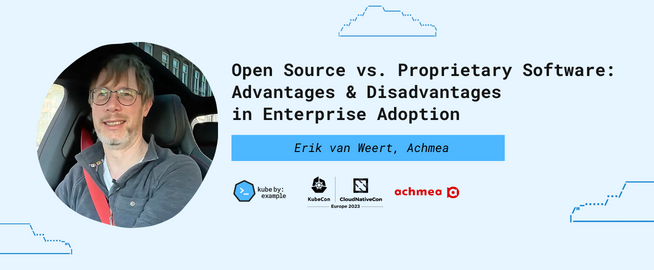Open Source vs. Proprietary Software: Key Advantages and Disadvantages in Enterprise Adoption
In this article, Erik van Weert, Solution Architect of OpenShift at Achmea, one of the largest insurance companies in the Netherlands, recently shared his perspectives on open source and proprietary enterprise software. Erik has many years of experience working with both open source and proprietary enterprise software systems.
Advantages of Open Source Software
According to Erik, the main advantage of open source software is the speed of innovation. The open source community is able to iterate and improve open source software much faster than commercial software vendors. With open source software, Erik said, “I can help look at the software, understand how it works [and] helps me use the software right.” In contrast, with proprietary software, “It's a big package, it's complex, I don't understand it and I can probably use 10 or 20% of it.”
The openness and transparency of open source software also makes it more usable, according to Erik. “There are so many people that are working around it. I can contact them, ask them for help, look at the documentation, [and] contribute.” The open source community provides more opportunities for support and collaboration compared to the closed-source model of proprietary software.
Erik also mentions that users can align their trade-offs with open source software trade-offs by examining the source code. This allows the software to "think like them," enabling more efficient usage. By understanding the design choices and trade-offs made in an open source project, users can adapt that software in a way that aligns with their own goals and trade-offs. This synergy leads to more effective usage of the software. Proprietary software vendors make trade-offs for the "average" user that may not align well with specific organizations. Open source gives power to the user rather than the vendor by exposing trade-offs and source code.
Disadvantages of Open Source Software
However, the open source model also comes with some significant downsides, especially for enterprise adoption. The most obvious disadvantage is the lack of a single commercial entity that can provide technical support and ensure continuity. With so many open source software tools to choose from, it can also be difficult for enterprises to determine which solutions are the most mature, stable, and suitable for their needs. Proprietary software vendors aim to address these types of challenges, offering enterprises more standardized solutions and dedicated commercial support.
Adopting Open Source at Achmea
According to Erik, adopting open source software successfully within an enterprise requires highly skilled engineers who can assess different open source solutions, determine how to best leverage and possibly contribute to them, and provide guidance to other teams. Without proper expertise, an organization can end up simply replicating their legacy infrastructure in the cloud rather than benefiting from more modern open source technologies built for the cloud native era.
At Achmea, Erik’s team provides a Red Hat OpenShift platform as a service to enable software development teams to adopt container and Kubernetes technologies. However, Erik noted that development teams have varying levels of skills and interests in infrastructure and container orchestration. His team is working to provide more customized offerings and services to address the specific needs of different teams. This includes both offloading engineering work from development teams when needed as well as giving more control to highly skilled teams that want it.
Erik's team initially gave developers namespaces on OpenShift but are now diversifying their portfolio to help less technical teams. They provide namespaces for technical teams that "want control" and services for less technical teams that "don't need to think about technology". This dual approach caters to Achmea's "diversified set of engineers" with varying skill levels.
Closing Thoughts
The journey to cloud native is ongoing at most enterprises, but open source software and community support have been instrumental in enabling it. According to Erik, with the right in-house expertise, open source solutions can significantly accelerate an organization’s digital transformation. However, as with any technology, understanding the pros and cons in the context of your organization’s needs and capabilities is key to success.
Erik's insights provide a valuable glimpse into how Achmea leverages open source technologies and manages the associated complexities. Overall, open source software has clearly been very beneficial but must be approached strategically, especially within large enterprises. With platforms like Red Hat OpenShift and guidance from experts like Erik, organizations can more confidently embrace open source solutions while still maintaining the reliability and support they depend on.
Full video at: KBE Insider Amsterdam
Follow us: @kubebyexample
Leave anonymous feedback
Join the KBE community forum
